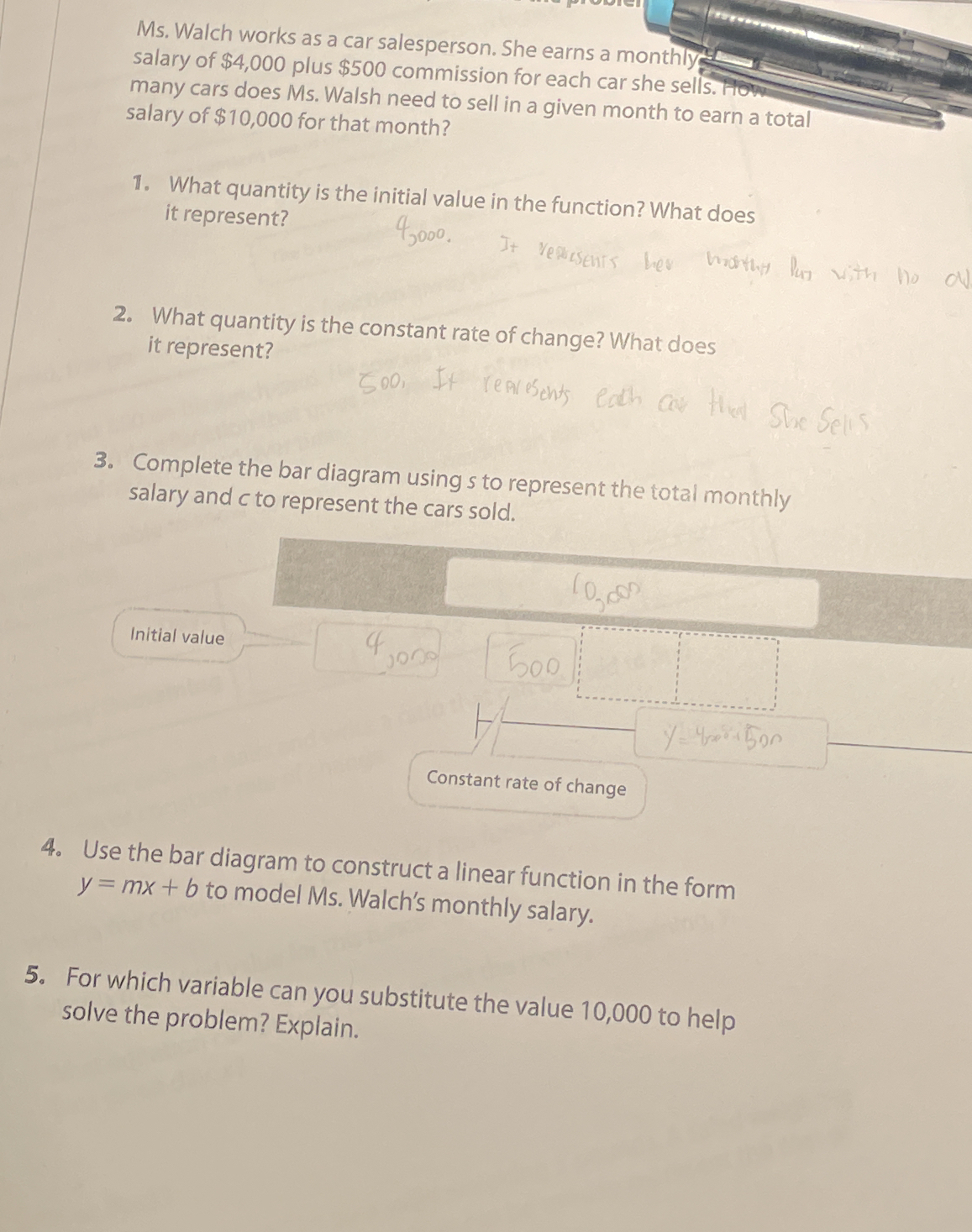Ms. Walch works as a car salesperson. She earns a monthly salary of $4,000 plus $500 commission for each car she sells. How many cars does Ms. Walsh need to sell in a given month t... Ms. Walch works as a car salesperson. She earns a monthly salary of $4,000 plus $500 commission for each car she sells. How many cars does Ms. Walsh need to sell in a given month to earn a total salary of $10,000 for that month? 1. What quantity is the initial value in the function? What does it represent? 2. What quantity is the constant rate of change? What does it represent? 3. Complete the bar diagram using s to represent the total monthly salary and c to represent the cars sold. 4. Use the bar diagram to construct a linear function in the form y = mx + b to model Ms. Walch's monthly salary. 5. For which variable can you substitute the value 10,000 to help solve the problem? Explain.

Understand the Problem
The student is working through a problem involving linear functions and salary calculations. The task involves identifying initial values, rates of change, constructing a bar diagram, forming a linear function, and determining where to substitute a given value to solve the problem. It appears to be a homework question.
Answer
1. $4,000, base salary. 2. $500, commission per car. 3. Bar diagram completed as described above. 4. $y = 500x + 4000$ 5. Substitute $10,000$ for $y$.
Answer for screen readers
- Initial value: $4,000. It represents her base monthly salary.
- Constant rate of change: $500. It represents the commission earned per car sold.
- The bar diagram has a total length representing $10,000. The first segment represents the initial value of $4,000. The remaining length is divided into 12 segments, each representing $500 earned per car sold.
- $y = 500x + 4000$
- Substitute $10,000$ for $y$, because $y$ represents the total monthly salary, which is given as $10,000.
Steps to Solve
- Identify the initial value
The initial value, also known as the y-intercept, is Ms. Walch's base salary before any cars are sold. This is $4,000.
- Identify the constant rate of change
The constant rate of change, also known as the slope, is the commission she earns for each car sold. This is $500 per car.
- Complete the bar diagram
The total salary is represented by the full bar, which equals $10,000. The initial value is $4,000. Each car sale adds $500. To reach $10,000, we need to find how many $500 increments are needed beyond the initial $4,000. $10,000 (Total) = $4,000 (Initial) + $500(Car 1) + $500(Car 2) + ...+ $500(Car n)$ The bar diagram has the total salary ($10,000) at the top, the initial value ($4,000) as the first segment, and the rest of the bar broken into increments of $500, representing each car sold. So we need ($10,000-$4,000)/$500 worth of $500 increments. $$ \frac{10,000 - 4,000}{500} = \frac{6,000}{500} = 12 $$ So we will have 12 increments/boxes representing 12 cars sold in the bar diagram.
- Construct a linear function
Using the slope-intercept form $y = mx + b$, where $y$ is the total salary, $m$ is the commission per car, $x$ is the number of cars sold, and $b$ is the base salary, the equation is:
$y = 500x + 4000$
- Identify the variable for substitution
We are given the total salary Ms. Walch wants to earn ($10,000). This value should be substituted for the variable $y$ which represents the total salary in the derived equation. We can then solve for $x$ to find number of cars she needs to sell.
- Initial value: $4,000. It represents her base monthly salary.
- Constant rate of change: $500. It represents the commission earned per car sold.
- The bar diagram has a total length representing $10,000. The first segment represents the initial value of $4,000. The remaining length is divided into 12 segments, each representing $500 earned per car sold.
- $y = 500x + 4000$
- Substitute $10,000$ for $y$, because $y$ represents the total monthly salary, which is given as $10,000.
More Information
The slope-intercept form is a common way to represent linear equations. It directly shows the starting point (y-intercept) and the rate of change (slope). It's widely used in real-world scenarios like calculating costs, distances, and salaries which make it very intuitive to apply and understand.
Tips
A common mistake would be reversing the slope and y-intercept in the equation. Another mistake would be to substitute the $10,000 for $x$ instead of $y$. People may also complete the bar diagram incorrectly, using the total salary for the first segment and not the $4,000 initial value.
AI-generated content may contain errors. Please verify critical information